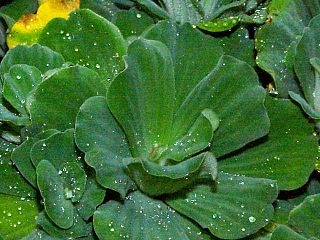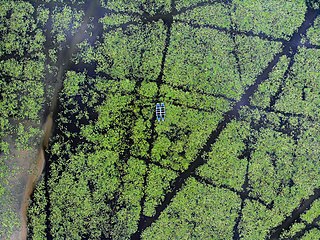
Stratiotes is a genus of submerged aquatic plant commonly known as water soldiers, described as a genus by Linnaeus in 1753. Several specific names have been coined within the genus, but at present only one is recognized: Stratiotes aloides. native to Europe and NW Asia.

Pistia is a genus of aquatic plants in the arum family, Araceae. It is the sole genus in the tribe Pistieae which reflects its systematic isolation within the family. The single species it comprises, Pistia stratiotes, is often called water cabbage, water lettuce, Nile cabbage, or shellflower. Its native distribution is uncertain but is probably pantropical; it was first discovered from the Nile near Lake Victoria in Africa. It is now present, either naturally or through human introduction, in nearly all tropical and subtropical fresh waterways and is considered an invasive species as well as a mosquito breeding habitat. The genus name is derived from the Greek word πιστός (pistos), meaning "water," and refers to the aquatic nature of the plants. The specific epithet is also derived from a Greek word, στρατιώτης, meaning "soldier," which references the sword-shaped leaves of some plants in the Stratiotes genus.

The Fucales (fucoids) are an order in the brown algae. The list of families in the Fucales, as well as additional taxonomic information on algae, is publicly accessible at Algaebase.

Stratiotes aloides, commonly known as water soldiers or water pineapple, is a submerged aquatic plant native to Europe and northwestern Asia. In Britain it was once common in East Anglia and still is in many places, particularly wet ditches and healthy ponds. It is the only species in the genus Stratiotes.
Phaio is a genus of moths in the subfamily Arctiinae.
Stratiotes is a genus of beetles in the family Carabidae, containing the following species:

Graphium stratiotes is a butterfly found in Borneo that belongs to the swallowtail family.
Phaio acquiguttata is a moth of the subfamily Arctiinae. It was described by Paul Dognin in 1909. It is found in Colombia.
Phaio albicincta is a moth of the subfamily Arctiinae. It was described by Schaus in 1896. It is found in Ecuador.
Phaio aurata is a moth of the subfamily Arctiinae. It was described by Schaus in 1892. It is found in Peru.
Phaio bacchans is a moth of the subfamily Arctiinae. It was described by Schaus in 1892. It is found in Peru.
Phaio caeruleonigra is a moth of the subfamily Arctiinae. It was described by Schaus in 1905. It is found in Peru.
Phaio cephalena is a moth of the subfamily Arctiinae. It was described by Druce in 1883. It is found in Colombia and Ecuador.
Phaio geminiguttata is a moth of the subfamily Arctiinae. It was described by Paul Dognin in 1911. It is found in Colombia.
Phaio longipennis is a moth of the subfamily Arctiinae. It was described by Berthold Neumoegen in 1894. It is found on Cuba. The specific name was spelled "longipenuis" in the original 1894 description, and emended to "longipennis" in 1898; under ICZN Article 33.2.3.1 the emended spelling is to be preserved.
Phaio quadriguttata is a moth of the subfamily Arctiinae. It was described by Paul Dognin in 1909. It is found in Ecuador.
Phaio salmoni is a moth of the subfamily Arctiinae. It was described by Herbert Druce in 1883. It is found in Colombia.
Phaio sylva is a moth of the subfamily Arctiinae. It was described by Schaus in 1896. It is found in Brazil.
Phaio unimacula is a moth of the subfamily Arctiinae. It was described by Rothschild in 1911. It is found in Peru.

Kondakarla Ava is a famous lake and bird sanctuary in Visakhapatnam of Andhra Pradesh state in South India. It comprises a unique and endangered forest type. It is located in the foothills of Eastern Ghats.





